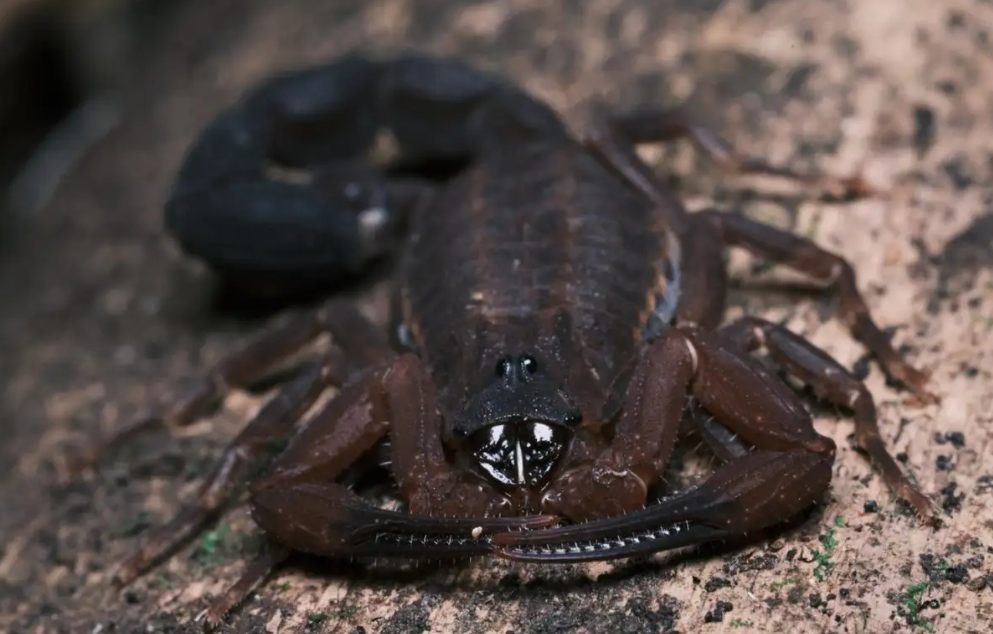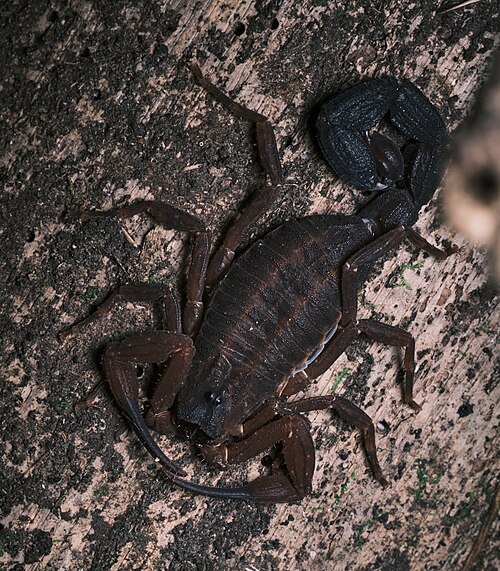Introduction
In a groundbreaking scientific discovery, researchers have Newly Identified Scorpion Species in Colombia that exhibits a unique defensive behavior: it spits venom to deter predators. Named Tityus achilles, this scorpion species is the first of its kind documented in South America capable of venom projection—a defense previously known only in select African and North American scorpions. This astonishing finding not only expands our understanding of scorpion behavior but also offers profound insights into venom evolution, ecological interactions, and potential biomedical applications.
This article explores the characteristics, behavior, venom composition, ecological role, and significance of Tityus achilles in the broader context of arachnid biology and venom research.

Discovery and Habitat
Tityus achilles was discovered in the Magdalena rainforest region within the Cundinamarca department of Colombia. The region’s mountainous terrain and rich biodiversity make it a hotspot for new species discoveries.
The discovery was detailed in a scientific paper published in December 2024 in the Zoological Journal of the Linnean Society by researcher Léo Laborieux, who was a master’s student at Ludwig Maximilian University of Munich at the time. The unique venom-spraying behavior was first noted accidentally when the scorpion sprayed venom while trapped inside a container. Further experimentation confirmed that it could spray venom accurately up to 35 centimeters (about 14 inches), aiming for sensitive areas such as eyes to maximize deterrence.
Venom Spitting: An Evolutionary Innovation
The ability to spit venom is a rare trait and marks a significant evolutionary divergence. While over 2,500 scorpion species exist globally, only a select few are known to spray venom regularly. Until this discovery, those species were limited to particular genera found in Africa and North America.
Mechanism of Venom Projection
Tityus achilles uses two venom projection modes:
- Spraying Prevenom-Like Fluid: This is a clear, less concentrated liquid the scorpion sprays as a first line of defense. It is energetically cheaper to produce and serves to quickly deter predators.
- Projection of Full Venom: Used during heightened threat levels, this more opaque and toxic venom is ejected when necessary, providing a stronger deterrent.
The venom spray behavior helps the scorpion escape dangerous encounters by temporarily incapacitating predators without engaging in close combat, which could be costly.
Venom Composition and Effects
Scorpion venom is a complex cocktail of neurotoxins, enzymes, peptides, and other compounds that disrupt normal physiological processes in prey or predators. Neurotoxins target ion channels—such as sodium, potassium, calcium, and chloride channels—interfering with nerve signal transmission.
In Tityus achilles, the venom spray primarily affects vertebrate predators by targeting sensitive areas, causing pain, temporary blindness, or disorientation. Compared to injected venom, the spray is less lethal but serves a critical role in defense by providing the scorpion an opportunity to escape.
Ecological Role and Predator Deterrence
The venom-spitting mechanism represents a sophisticated adaptation to defend against larger vertebrates such as birds, rodents, or reptiles. Prior species had restricted venom delivery to direct stings, which require close contact and increase injury risk to the scorpion.
By spraying venom from a distance, Tityus achilles minimizes these risks. The strategy illustrates a remarkable convergence with venom-spitting snakes, which similarly use ranged venom delivery to protect themselves.

Comparison With Other Venom-Spraying Species
Before this discovery, venom spitting was documented in:
- African genera such as Parabuthus, known for painful and potentially harmful venom sprays causing temporary blindness.
- North American species exhibiting varying degrees of venom projection.
Tityus achilles stands out by being the first South American species exhibiting such behavior, signaling a broader geographical spread and evolutionary significance of venom spraying.
Importance of Prevenom Use
Prevenom, also known as pre-venom fluid, is a less potent secretion used by some scorpions. It conserves the energetically expensive full venom, which is crucial for both defense and prey capture. The scorpion’s deliberate use of prevenom in sprays points to a strategic balance between energy conservation and effective deterrence.
Behavior and Survival Strategies
Aside from venom spraying, scorpions have multiple defense mechanisms:
- Pincers (Pedipalps): Used for grabbing and physical defense.
- Stingers: For injecting venom during attacks.
- Camouflage & Burrowing: To avoid detection.
The choice to spray venom reflects an evolutionary pressure to survive against predators that are too large or numerous to engage in direct combat.
Venom Research and Biomedical Potential
Scorpion venom research is a growing field, with components showing promise in drug development for:
- Pain relief
- Cancer therapies
- Antimicrobial agents
Understanding the unique venom of Tityus achilles opens new avenues for discovering bioactive compounds with potential medical uses.
Conservation and Scientific Significance
The discovery of Tityus achilles highlights the richness of biodiversity in Colombian rainforests and emphasizes the importance of preserving these habitats. As scientific efforts continue to uncover new species and behaviors, conservation becomes paramount to safeguard ecological balances.
Conclusion
Tityus achilles challenges our understanding of scorpion biology and venom use by unveiling a rare and sophisticated venom spraying defense. This discovery enriches scientific knowledge of arachnid adaptations and underscores the importance of continued biodiversity exploration.
References
- https://www.youtube.com/watch?v=UevTnHFDcv8
- https://www.newscientist.com/article/2459777-newly-identified-scorpion-species-spits-venom-to-defend-itself/
- https://www.earthtouchnews.com/discoveries/new-species/venom-spraying-scorpion-the-first-of-its-kind-in-south-america
- https://www.livescience.com/animals/arachnids/scientists-discover-rare-venom-spraying-scorpion-in-columbia
- https://timesofindia.indiatimes.com/etimes/trending/venom-spraying-scorpion-found-in-colombia-scientists-are-stunned-by-this-deadly-discovery/articleshow/117759153.cms
- https://uk.news.yahoo.com/strange-scorpion-species-sprays-venom-101821075.html
- https://phys.org/news/2013-11-scorpions-strongest-defense-mechanisms.html
- https://www.independent.co.uk/news/science/scorpion-venom-spraying-species-discovery-b2712721.html
- https://www.sciencedirect.com/science/article/abs/pii/S0376635715000753
- https://www.sciencedaily.com/releases/2013/11/131113182600.htm
- https://www.biorxiv.org/content/10.1101/2024.07.25.605134v1
- http://novataxa.blogspot.com/2025/01/tityus.html
- https://pmc.ncbi.nlm.nih.gov/articles/PMC12080380/
- https://www.iflscience.com/brand-new-species-of-scorpion-is-a-venom-spraying-badass-from-columbia-77756
- https://besjournals.onlinelibrary.wiley.com/doi/10.1111/1365-2435.12855
- https://www.sciencedirect.com/science/article/pii/S2772417422000401
- https://www.frontiersin.org/journals/ecology-and-evolution/articles/10.3389/fevo.2019.00196/epub
- https://emedicine.medscape.com/article/168230-overview
- https://www.msdvetmanual.com/toxicology/venomous-arthropods/spider-and-scorpion-bites-in-animals
- https://www.sciencedirect.com/science/article/abs/pii/S0306456524001840
